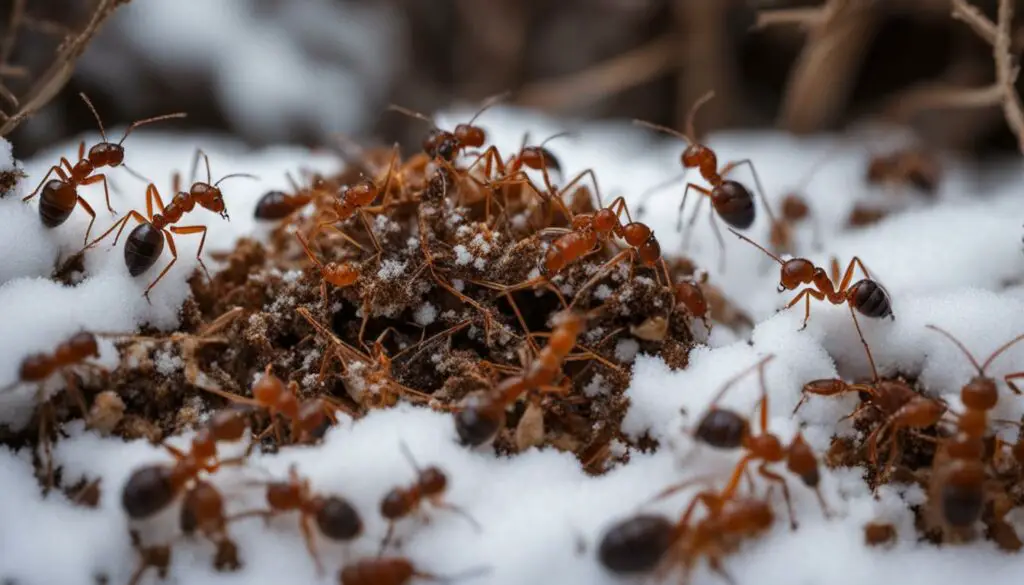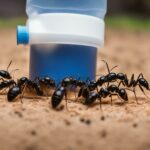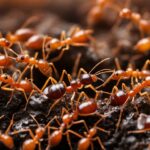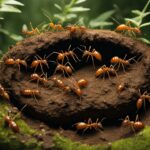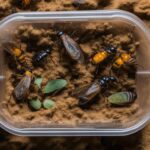Greetings fellow ant enthusiasts! As winter approaches, it’s important to prepare and care for our tiny friends, ensuring their survival and well-being during the cold months. In this comprehensive guide, I will share my expertise and proven strategies for keeping ants healthy and thriving in winter conditions. From understanding their unique challenges to creating suitable habitats, managing temperature and nutrition, and even troubleshooting common issues, I’ve got you covered.
Join me on this exciting journey as we delve into the world of ant winter care. Together, we will discover how to navigate the intricacies of ant hibernation, winterize their habitats, and provide the necessary support for their survival. Whether you’re a beginner or a seasoned ant keeper, this guide will equip you with the knowledge and practical tips to ensure a successful winter ant keeping experience.
Key Takeaways:
- Understanding the challenges ants face during winter is vital for their care and well-being.
- Creating suitable winter habitats, including insulation and food storage, is crucial for ant survival.
- Managing temperature and humidity levels is essential to ensure a comfortable environment for ants.
- Feeding strategies should be adjusted to meet ants’ specific dietary needs during the dormant period.
- Regular monitoring of ant health and taking preventive measures against pests are important in winter care.
Understanding Winter Challenges for Ants
During the winter months, ants face unique challenges as they enter a state of hibernation. It’s important to understand the natural behavior of ants during this period and how to prepare them for the dormant season. By providing the right care and environment, you can ensure the health and well-being of your ants throughout the winter.
Ant hibernation is a natural process that helps ants conserve energy and survive the cold temperatures. Their activity slows down significantly, and they enter a state of dormancy. This means that their nutritional needs change, and they require less food and water during the winter. Understanding these changes is crucial for their overall care.
Preparing ants for winter involves creating suitable habitats that mimic their natural environment. This includes providing insulation to keep them warm, controlling moisture levels to prevent mold and fungus growth, and ensuring they have enough food storage to sustain them throughout the dormant period. By addressing these winter-specific needs, you can help your ants thrive even in the coldest months.
Overwintering ants successfully requires careful temperature and humidity management. Maintaining the right conditions is essential for their survival. This can be achieved through the use of heating devices, thermal insulation, and misting systems to regulate temperature and humidity levels. By providing a comfortable environment, you can ensure that your ants remain healthy and active during their hibernation.
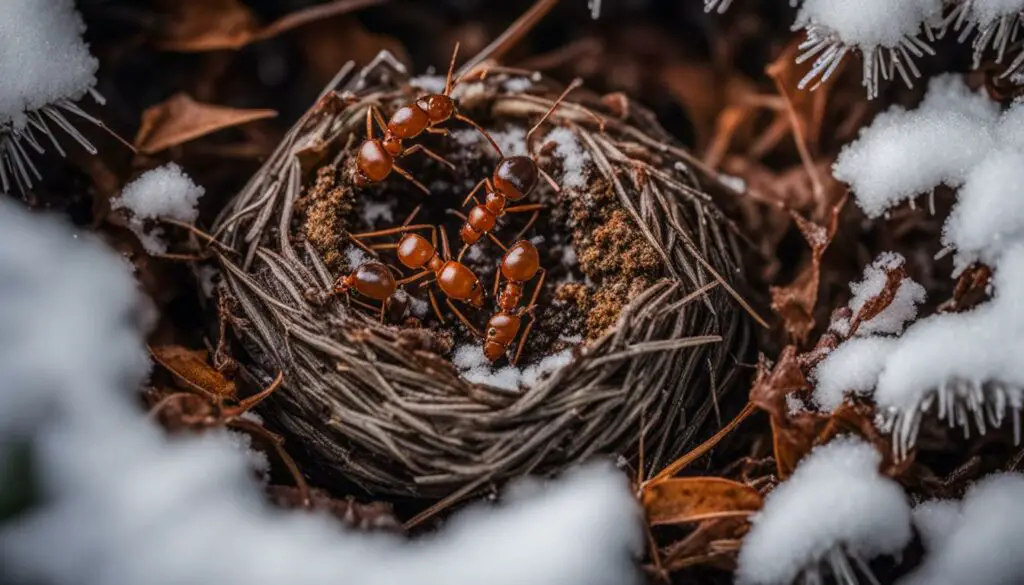
Table: Checklist for Preparing Ants for Winter
| Aspect | Actions |
|---|---|
| Insulation | Provide insulation materials to keep the ant habitat warm. |
| Moisture Control | Monitor humidity levels and adjust as needed to prevent mold and fungus growth. |
| Food Storage | Ensure ants have enough food stored for the winter period. |
| Temperature Management | Use heating devices to maintain a suitable temperature for ants. |
| Humidity Regulation | Utilize misting systems or other methods to control humidity levels. |
By understanding and addressing the winter challenges for ants, you can provide the necessary care and support for their hibernation period. The next section will focus on creating suitable winter habitats for ants, further ensuring their well-being during the colder months.
Creating Suitable Winter Habitats for Ants
Creating a suitable habitat for ants during winter is essential to ensure their survival and well-being. The winter environment poses unique challenges to ants, and by providing the right conditions, we can help them thrive even in the coldest months. Here are some important tips on winterizing ant habitats to ensure the comfort and health of your ant colonies.
Insulation
Insulating the ant habitat is crucial to regulate temperature and protect the ants from extreme cold. Use materials like foam or cork to line the walls and bottom of the ant nest. This helps retain heat and prevents the habitat from getting too cold. It is also important to ensure that there are no gaps or cracks where cold air can seep in.
Moisture Control
Proper moisture control is essential for ants during winter. Monitor the humidity levels in the ant habitat regularly and make adjustments as needed. Too much moisture can lead to mold growth, while excessively dry conditions can cause dehydration. Use a hygrometer to measure humidity and provide a water source such as a moist cotton ball or a water-filled test tube to maintain the ideal moisture level.
Food Storage
Ants need to have access to sufficient food during winter when foraging becomes limited. Ensure that the ant habitat has ample food storage areas. Use small containers or test tubes to store food, such as sugar water or protein-rich sources like insects or seeds. This ensures that the ants have a readily available food supply, reducing stress and ensuring their nutritional needs are met throughout the dormant period.
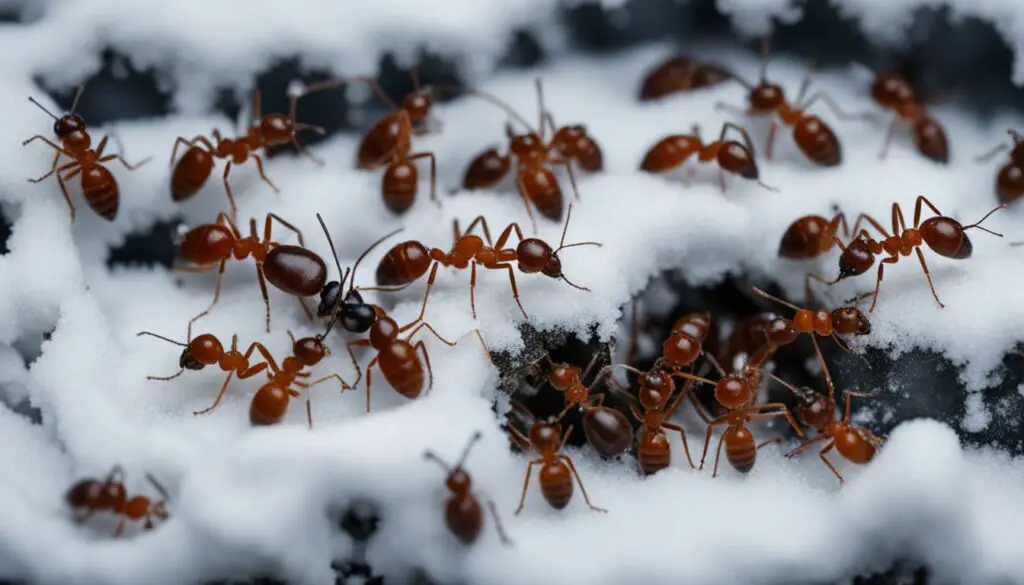
Remember, creating a suitable winter habitat for ants requires careful attention to insulation, moisture control, and food storage. By providing the right conditions, you can help your ant colonies not just survive but thrive during the winter months.
Managing Temperature and Humidity for Ants in Winter
When it comes to caring for ants during the winter season, maintaining optimal temperature and humidity levels is crucial for their well-being and survival. As ants enter a state of hibernation, it’s important to create a comfortable environment that mimics their natural habitat.
To control temperature, consider using heating devices such as heat mats or cables placed under the ant habitat. These tools can provide a gentle and consistent heat source, keeping the temperature within the desired range. It’s important to monitor the temperature regularly to ensure it remains stable and doesn’t get too hot or too cold.
In addition to temperature control, regulating humidity is equally important. Ants require a certain level of moisture to stay hydrated and prevent dehydration during the winter months. One way to maintain humidity is by using a misting system or a humidifier. These devices can provide a fine mist of water, creating a slightly humid environment for the ants.
Monitoring and Adjusting
Regular monitoring of temperature and humidity is essential to ensure they are within the appropriate range for your specific ant species. Use a thermometer and hygrometer to measure these factors accurately. If you notice any fluctuations or deviations from the optimal range, you may need to make adjustments to maintain a stable environment for your ants.
| Temperature | Humidity | |
|---|---|---|
| Species A | 65-75°F | 50-60% |
| Species B | 70-80°F | 60-70% |
| Species C | 75-85°F | 70-80% |
It’s important to note that different ant species may have slightly different temperature and humidity requirements. Refer to specific care guides or consult with ant keeping communities to ensure you are providing the right conditions for your ants.
By effectively managing temperature and humidity, you can create a comfortable and suitable environment for your ants during the winter season, promoting their health and well-being.
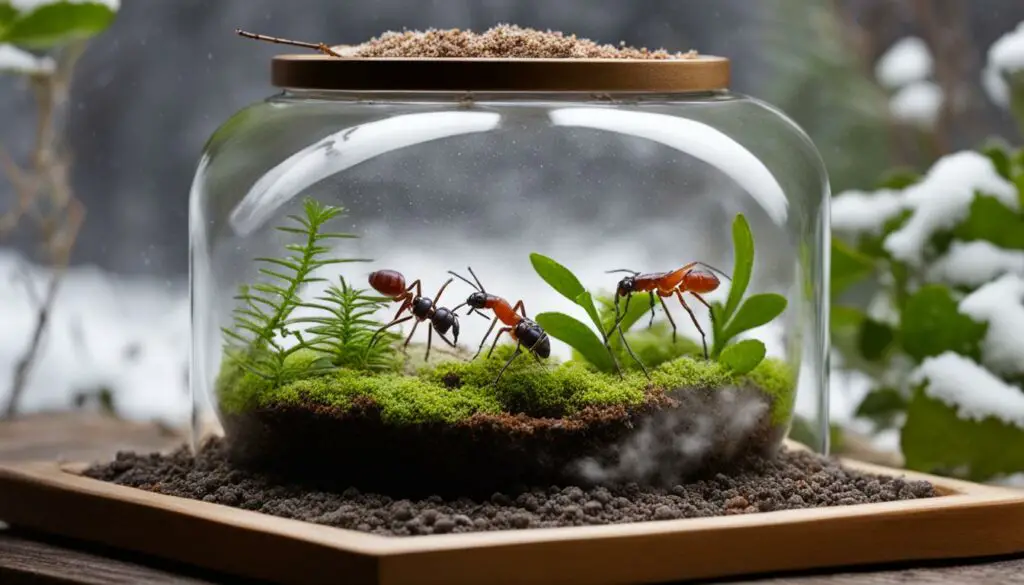
Feeding Strategies for Ants in Winter
In winter, ants have different dietary needs compared to other seasons. It’s important to provide them with the right nutrition to ensure their survival and well-being. Here are some feeding strategies for ants in winter:
- Store enough food: Ants will have limited foraging opportunities during winter, so it’s crucial to have a sufficient supply of food stored in their habitat. This can include a variety of foods such as sugar water, honey, small insects, and seeds.
- Provide a balanced diet: Ants require a balanced diet to meet their nutritional needs. This can include a combination of proteins, carbohydrates, and fats. Offering a variety of food sources will help ensure they receive the necessary nutrients.
- Monitor food consumption: Keep track of how much food the ants are consuming to prevent overfeeding or food waste. Adjust the amount of food provided based on their needs and consumption patterns.
- Minimize spoilage: To avoid food spoilage, remove any uneaten or spoiled food promptly. This will help maintain a clean and hygienic environment for the ants.
- Offer occasional treats: While ants primarily feed on their stored food, occasionally providing treats such as small fruits or vegetables can add variety to their diet and stimulate their foraging instincts.
Table: Recommended Foods for Ants in Winter
| Food Type | Examples |
|---|---|
| Protein | Fruit flies, small pieces of cooked meat, crickets |
| Carbohydrates | Sugar water, honey, small pieces of fruits |
| Fats | Small seeds, nuts |
It’s important to observe the eating habits of the ants and adjust their diet accordingly. Remember to provide a clean and hygienic feeding area, and always use fresh food to ensure the best nutrition for the ants throughout the winter season.
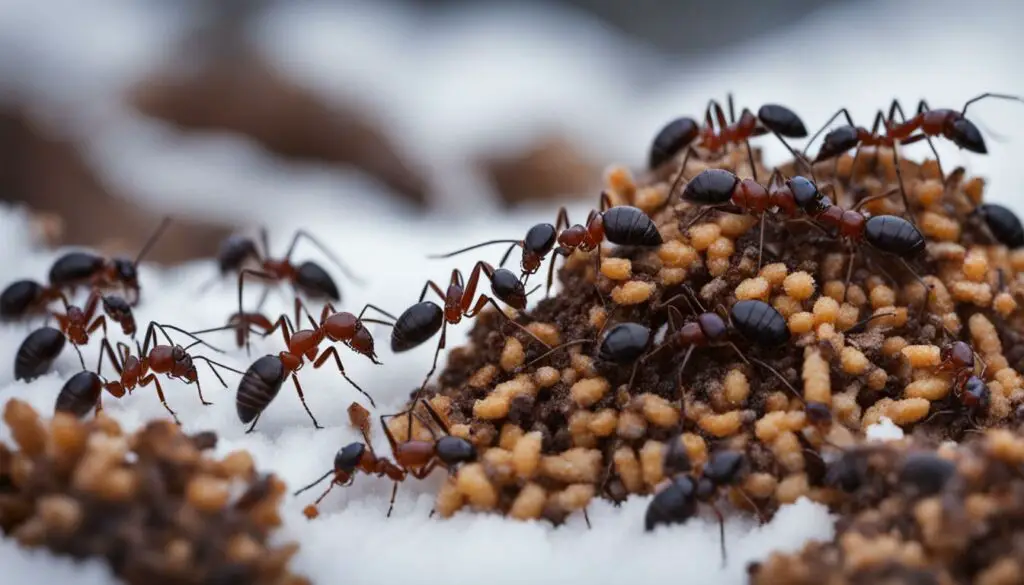
Watering and Hydration for Ants in Winter
Proper hydration is vital for the well-being of ants, even during winter when their water needs are reduced. While ants require less water during the cold season, they still need a source of hydration to stay healthy. In this section, I will provide you with essential tips on how to provide water for ants in winter and emphasize the importance of maintaining adequate hydration levels to prevent dehydration.
Preventing Dehydration
During winter, ants’ activity levels decrease, resulting in a reduced need for water. However, it’s crucial to ensure that your ants have access to water to prevent dehydration. To achieve this, you can place a small water source in their habitat, such as a shallow dish or cap filled with fresh water. However, it’s essential to monitor the water source regularly to prevent any contamination or drying out.
Water Storage Solutions
In addition to providing a direct water source, you can also consider incorporating water storage solutions within the ant habitat. Water crystals, also known as hydrogels, are a popular option for maintaining hydration levels. These crystals can absorb and retain water, slowly releasing it over time, providing a consistent water source for your ants. Another option is to create a moisture gradient within the habitat by spraying one side of the enclosure lightly with water. This allows the ants to regulate their hydration by moving to the desired humidity level.
“Proper hydration is crucial for the well-being of ants during winter.”
| Watering and Hydration Tips for Ants in Winter |
|---|
| 1. Monitor the water source regularly to ensure it remains clean and filled. |
| 2. Consider using water crystals or hydrogels to provide a consistent water source. |
| 3. Create a moisture gradient within the habitat for the ants to regulate their hydration levels. |
| 4. Avoid overwatering to prevent mold or excessive humidity. |
| 5. Use distilled or filtered water to avoid any potential contaminants. |
| 6. Observe the ants’ behavior closely to ensure they are adequately hydrated. |
By following these watering and hydration tips, you can ensure that your ants stay properly hydrated during the winter season. Remember to monitor their water sources, provide alternative moisture options, and pay close attention to their behavior to ensure their well-being. Keeping your ants hydrated is an essential part of their care, even when their water requirements are reduced during the colder months.
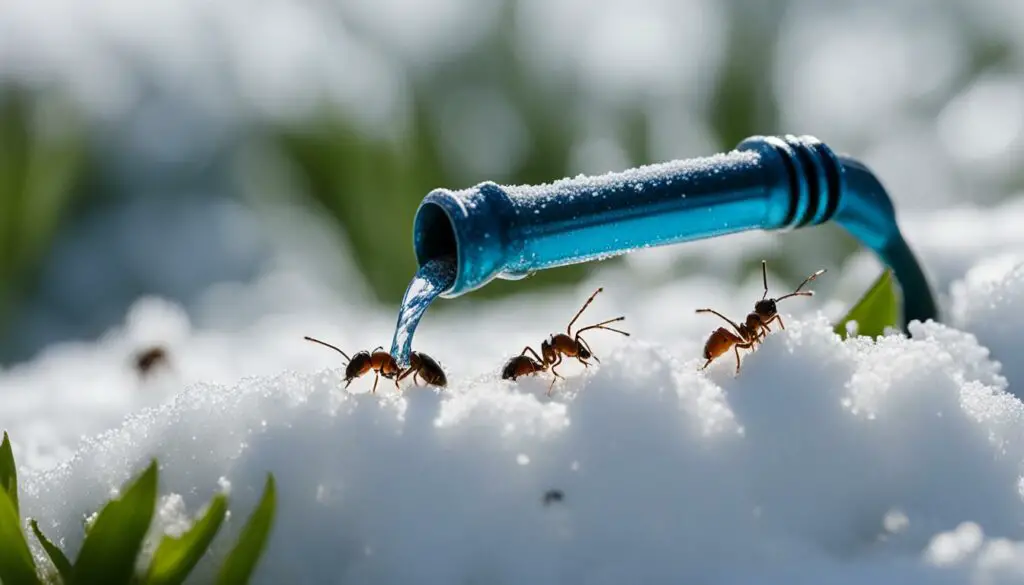
Managing Ant Nests and Colonies in Winter
Winter is a critical time for ant nests and colonies, as they require special care and protection to ensure their survival. As an ant keeper, it’s important to understand the unique challenges they face during this dormant period and implement strategies to safeguard their nests. By taking proactive measures, you can help your ant colonies thrive during the winter season and emerge strong and healthy in the spring.
Protecting Ant Nests
One of the key aspects of managing ant nests in winter is providing adequate insulation. Insulating the nest helps maintain a stable temperature for the ants, preventing extreme cold or heat fluctuations. To achieve this, you can use materials such as styrofoam or insulation boards to wrap around the nest, creating a protective barrier. It’s crucial to ensure that the insulation is secure and doesn’t restrict air flow, allowing the ants to breathe.
In addition to insulation, it’s important to protect ant nests from pests and predators. Common winter pests include mice, spiders, and other insects that may try to invade the nest for shelter or food. Regularly inspect the nest for signs of infestation and take appropriate measures to eliminate any pests. You can also create a perimeter barrier using diatomaceous earth or other natural deterrents to keep unwanted visitors away.
Overwintering Ant Colonies
Overwintering colonies involves managing the overall health and well-being of the ant population during the winter months. It’s essential to ensure that the colony has enough food and water to sustain them throughout the dormant period. Providing high-quality, nutrient-rich food sources like protein-rich insects or sugar water can help meet their dietary needs.
Water supply is equally important. While ants require less water during winter, they still need access to hydration. You can provide small water sources such as damp cotton balls or sponge pieces near the nest, ensuring that they do not become oversaturated and lead to mold growth. Regularly check and replace these water sources to maintain cleanliness.
| Key Steps for Managing Ant Nests and Colonies in Winter |
|---|
| 1. Insulate the ant nest with materials like styrofoam or insulation boards to regulate temperature. |
| 2. Protect the nest from pests and predators by regularly inspecting for infestation and using natural deterrents. |
| 3. Provide a sufficient food supply, including protein-rich insects and sugar water, to sustain the colony. |
| 4. Ensure access to water by placing small water sources near the nest, like damp cotton balls or sponge pieces. |
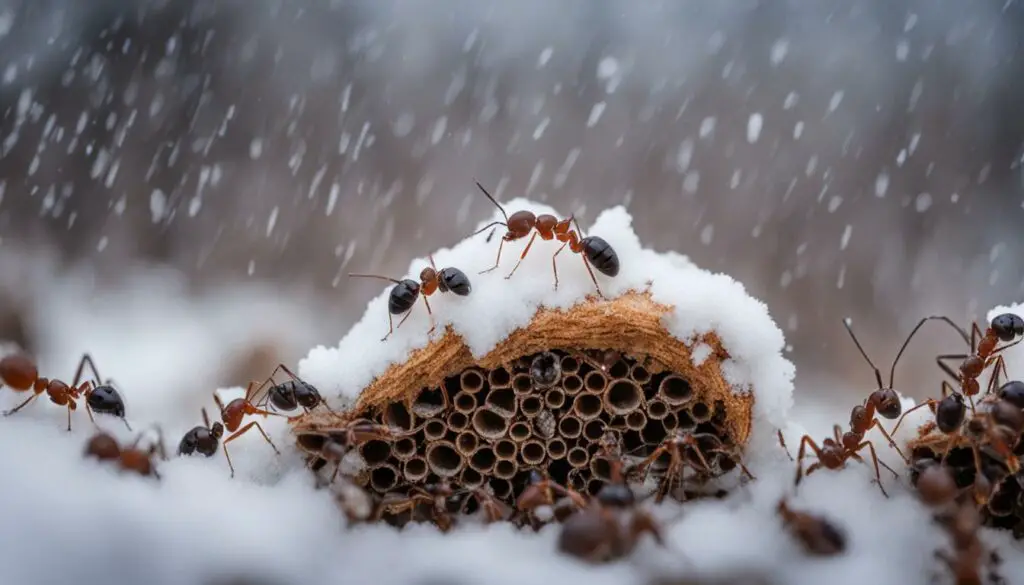
By implementing these strategies, you can effectively manage and protect ant nests and colonies in winter. Maintaining a stable and comfortable environment for your ants will increase their chances of survival and promote a thriving colony in the seasons to come.
Identifying and Preventing Winter Ant Pests
During the winter months, ants may face unwanted visitors that can pose a threat to their colonies. It is important to be vigilant and take proactive measures to identify and prevent these winter ant pests. By implementing effective pest control strategies, you can ensure the health and safety of your ant colonies throughout the winter season.
Common Winter Ant Pests
In order to effectively prevent pest infestations, it is crucial to familiarize yourself with the common winter ant pests. Some of the most prevalent pests include:
- Household pests like cockroaches and silverfish, which are attracted to food sources and can infiltrate ant colonies.
- Mites and parasitic insects that can prey on ants, weakening their colonies and causing potential harm.
- Other small insects and arthropods that may seek shelter and resources in ant habitats during the winter months.
By closely monitoring your ant colonies and their surroundings, you can quickly identify the presence of these pests and take appropriate action to prevent infestations.
Preventing Ant Infestations in Winter
Prevention is key to keeping your ant colonies safe from pests during the winter season. Here are some effective measures you can take:
- Keep your ant habitats clean and free from food debris, as this can attract unwanted pests.
- Seal any cracks or openings in your ant habitats to prevent pests from entering.
- Regularly inspect your ant colonies for signs of pests, such as unusual behavior or physical damage.
- Consider using natural pest repellents, such as diatomaceous earth or essential oils, to deter pests without harming your ants.
- If infestations occur, promptly remove affected ants and clean the habitat thoroughly to prevent further spread.
By implementing these preventive measures, you can create a pest-free environment for your ants and ensure their well-being throughout the winter season.
| Common Winter Ant Pests | Preventive Measures |
|---|---|
| Household pests | Keep ant habitats clean and free from food debris |
| Mites and parasitic insects | Seal cracks and openings in ant habitats |
| Other small insects and arthropods | Regularly inspect ant colonies for signs of pests |
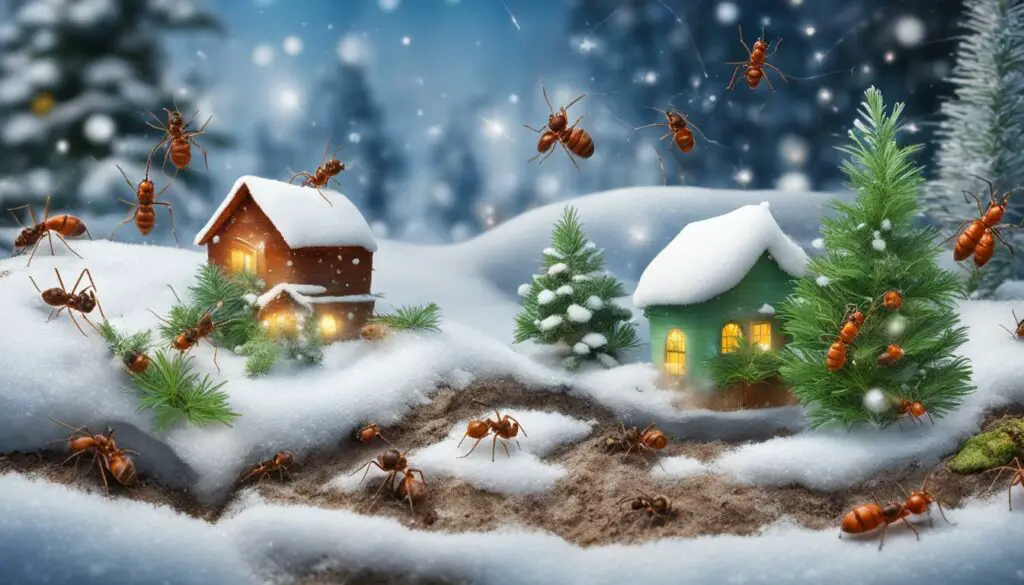
“Prevention is key to keeping your ant colonies safe from pests during the winter season.”
Monitoring Ant Health During Winter
During the winter months, it is important to monitor the health of your ants to ensure their well-being and detect any signs of illness or distress. By observing their behavior and appearance, you can identify potential problems early on and take necessary steps to address them. Here are some key factors to consider when monitoring the health of your ants in winter:
- Activity level: Ants naturally reduce their activity during winter, but a significant decrease in movement or complete inactivity may indicate a health issue. Keep an eye on their level of activity and look for any abnormal behavior.
- Appetite: While ants eat less during winter, a complete loss of appetite or refusal to eat may be a sign of illness. Monitor their feeding habits and ensure they have access to appropriate food sources.
- Physical appearance: Check your ants for any visible signs of illness, such as discolored or shriveled bodies, abnormal growths, or difficulty moving. Any changes in their appearance could indicate an underlying health problem.
If you notice any concerning signs or symptoms, it is essential to take prompt action to prevent further deterioration of their health. Consult a veterinarian or an experienced ant keeper for guidance on appropriate interventions and treatments.
Remember, regular monitoring is crucial to ensure the well-being of your ants during winter. By staying vigilant and addressing any health issues promptly, you can give your ants the best chance of thriving throughout the dormant season.
Winter Ant Reproduction and Queen Management
Winter poses unique challenges for ant reproduction and queen management. During this season, ants typically reduce their reproductive activities, but it is still important to ensure the health and success of your ant colonies. Understanding the reproductive behavior of ants in winter and implementing appropriate management strategies will help maintain the population and support the growth of your ant colonies.
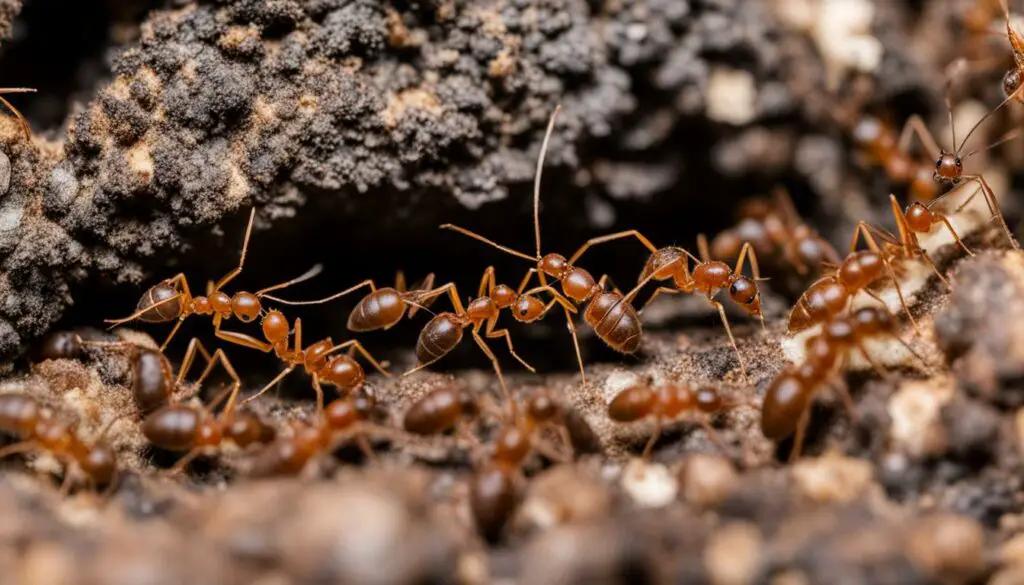
During winter, ant queens tend to lay fewer eggs as they conserve energy for surviving the cold months. It is essential to provide the queens with a suitable environment that encourages them to continue laying a limited number of eggs. Maintaining stable temperature and humidity levels in the ant habitat and ensuring a steady supply of food and water will support the queen’s reproductive activities.
Overwintering ant eggs is also a crucial aspect of winter ant care. These eggs, laid by the queen, are the future of your ant colony. To ensure their survival, it is important to create a protected and insulated environment for the eggs. The use of heat mats or cables can help regulate temperature, and providing additional insulation can prevent temperature fluctuations that may harm the developing eggs.
Monitoring the condition of the eggs and the behavior of the queen is vital during winter. If the queen shows signs of stress or fails to lay eggs, it may be necessary to intervene with appropriate measures. Consulting with ant experts and seeking guidance on queen management techniques can help ensure the long-term success of your ant colonies.
Essential Supplies and Equipment for Winter Ant Keeping
Proper supplies and equipment are essential for successful winter ant keeping. When preparing for the winter season, it’s important to have the following items on hand to ensure the well-being and comfort of your ant colonies:
- Heating devices: Invest in heating mats or cables specifically designed for ant habitats. These devices help maintain the ideal temperature range for ants during winter.
- Insulation materials: Insulate the outer walls of your ant habitat to keep the cold air out and preserve warmth inside. Use materials such as foam boards or reflective barriers to minimize heat loss.
- Food storage containers: Choose airtight containers to store ant food during winter. This prevents moisture from spoiling the food and keeps it fresh for longer.
- Misting system: Consider installing a misting system to regulate humidity levels inside the ant habitat. This helps replicate the natural conditions ants require during winter.
Additionally, it’s important to have ant care products specifically designed for winter conditions. These may include:
- Ant-safe dehumidifier: A dehumidifier helps control moisture levels in the ant habitat and prevents excessive humidity that can lead to mold or other issues.
- Ant-safe antifungal treatments: Ants are susceptible to fungal infections, especially in humid conditions. Use antifungal treatments specifically formulated for ants to prevent and treat these infections.
- Thermal imaging camera: A thermal imaging camera can be a useful tool for monitoring temperature distribution within the ant habitat. It allows you to identify any cold spots and make necessary adjustments to ensure adequate heating.
Remember to thoroughly research and select supplies and equipment that are safe and suitable for your specific ant species. Always prioritize the well-being and comfort of your ants when choosing and using these essential items.
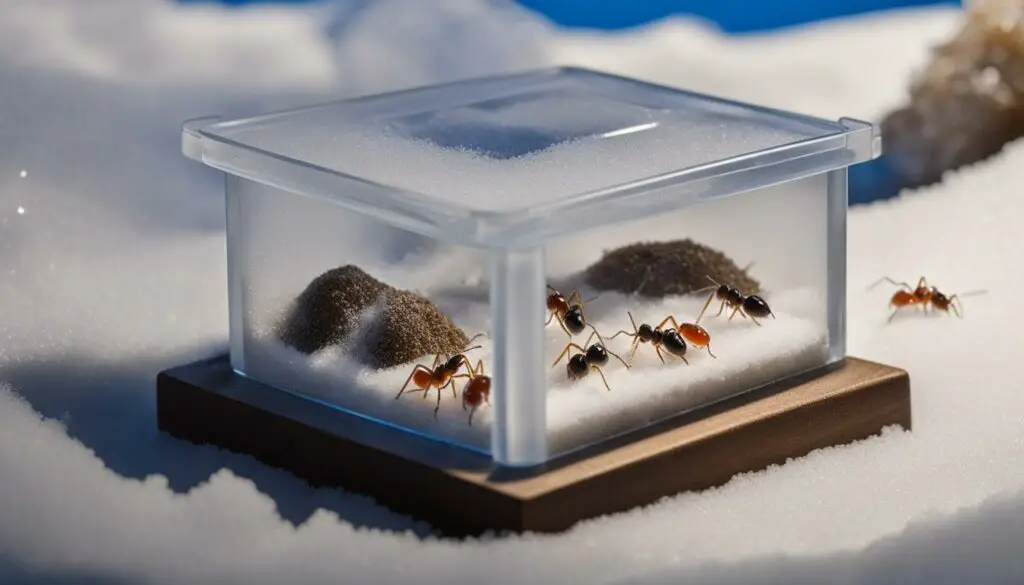
Troubleshooting Winter Ant Care Issues
Despite your best efforts, caring for ants in winter can sometimes present challenges. In this section, I will address common problems that may arise and provide troubleshooting tips to help you overcome these issues, ensuring the well-being of your ant colonies throughout the season.
One common challenge in winter ant keeping is maintaining the appropriate temperature and humidity levels. If you notice that the temperature is too low, consider using a heating device or insulating the ant habitat to provide a warmer environment for your ants. On the other hand, if the humidity is too high or too low, adjust it by misting the habitat or using a dehumidifier, respectively.
Another issue you may encounter is the presence of pests. Winter months can attract various pests that can harm ant colonies. To prevent infestations, regularly inspect the ant habitat for signs of pests and use effective pest control methods. Additionally, ensure that the ant habitat is properly sealed to prevent pests from entering.
Furthermore, if you notice any signs of illness or distress in your ants, it’s important to take immediate action. Monitor your ants closely for any unusual behaviors or physical abnormalities. If necessary, consult with a veterinarian who specializes in insect care to ensure proper diagnosis and treatment.
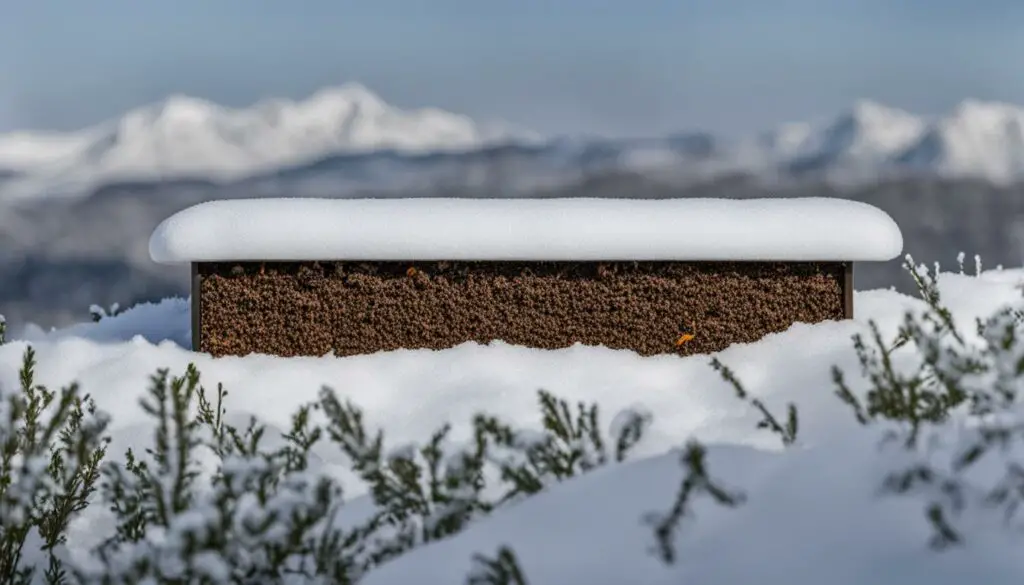
Possible Issues and Solutions:
| Issue | Solution |
|---|---|
| Low temperature | Use a heating device or insulate the habitat to provide a warmer environment. |
| High or low humidity | Adjust humidity levels by misting or using a dehumidifier. |
| Pest infestations | Inspect the habitat regularly and use effective pest control methods. Ensure proper sealing of the habitat. |
| Signs of illness or distress | Monitor closely and consult with a veterinarian specializing in insect care if needed. |
Ant Species-Specific Winter Care Guidelines
Each ant species has its own unique requirements for winter care. Understanding these specific needs is crucial for providing the best care and ensuring the survival of your ant colonies during the winter season. Here, I will provide you with species-specific guidelines for winter care, taking into account the hibernation requirements and behaviors of popular ant species.
Black Garden Ant (Lasius niger)
The Black Garden Ant is a common ant species known for its resilience and adaptability. During winter, these ants enter a state of hibernation characterized by reduced activity and suppressed metabolism. To care for Black Garden Ants during winter, it is important to provide them with a suitable habitat that replicates their natural environment. This includes maintaining a constant temperature between 40 and 50 degrees Fahrenheit and ensuring proper insulation to prevent temperature fluctuations.
Additionally, Black Garden Ants require a food source that is high in carbohydrates to sustain them throughout the winter. Supply them with a sugar-water solution or honey, and ensure that their food is easily accessible but does not encourage mold growth. Regularly check on the moisture levels in their habitat and provide a water source in the form of a damp cotton ball or sponge.
Harvester Ant (Pogonomyrmex spp.)
Harvester Ants are known for their ability to store food for the winter season. As the name suggests, they collect and store seeds in their nests, which serves as their primary source of food during hibernation. To care for Harvester Ants during winter, it is crucial to ensure that their food stores are well-stocked with a variety of seeds.
Keep their habitat at a cool temperature of around 50 degrees Fahrenheit to mimic their natural environment. Avoid excessive humidity, as it can lead to mold growth and affect the stored seeds. Regularly monitor their food supplies and replenish as needed. Harvester Ants are also highly sensitive to disturbances, so minimize any unnecessary disruptions to their nest during the winter months.
Carpenter Ant (Camponotus spp.)
The Carpenter Ant is a larger ant species known for building intricate nests in wood. During winter, Carpenter Ants enter a state of relative inactivity, but they still require appropriate care to ensure their well-being. To care for Carpenter Ants during winter, it is crucial to provide them with a properly insulated habitat that maintains a temperature range of 60 to 70 degrees Fahrenheit.
These ants have a diverse diet and require a combination of sugars and proteins to thrive. Offer them a mix of honey or sugar-water solution along with small insects or protein-rich foods. Ensure that their food is easily accessible and replace it regularly to prevent spoilage. Monitor the moisture levels in their habitat and provide a water source, such as a damp sponge or a water test tube.
Table: Ant Species-Specific Winter Care Guidelines
| Ant Species | Hibernation Requirements | Temperature | Food | Moisture |
|---|---|---|---|---|
| Black Garden Ant (Lasius niger) | Hibernates with reduced activity and suppressed metabolism | 40-50°F | Sugar-water solution or honey | Damp cotton ball or sponge |
| Harvester Ant (Pogonomyrmex spp.) | Stores seeds for winter food source | 50°F | A variety of seeds | Avoid excessive humidity |
| Carpenter Ant (Camponotus spp.) | Enters a state of relative inactivity | 60-70°F | Mix of sugars and proteins | Monitor and provide moisture as needed |
By following these species-specific guidelines, you can provide optimal care for ants during the winter season. Remember to observe their behavior and make adjustments as needed to ensure their comfort and well-being throughout the dormant period.
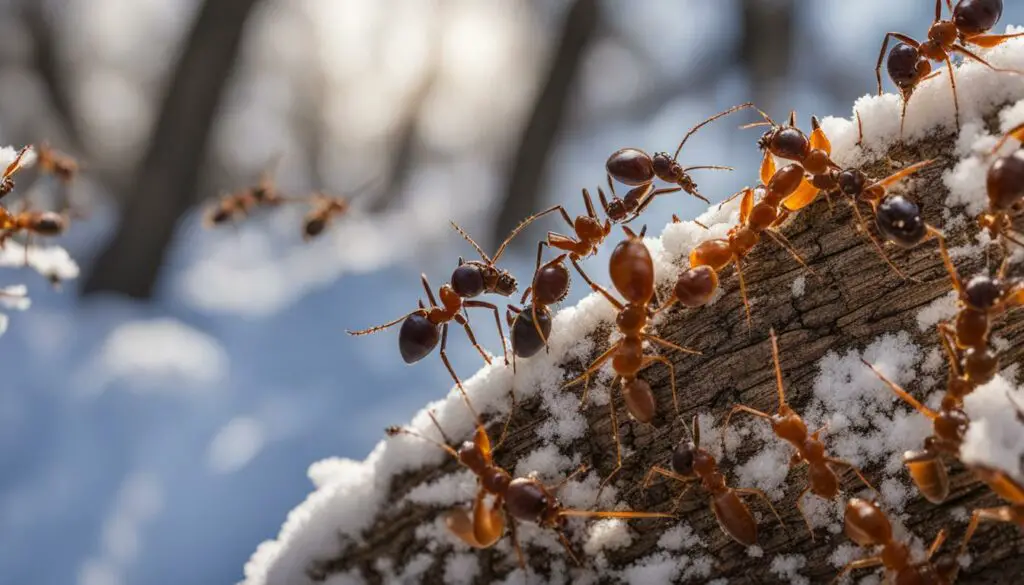
Ant Winter Care FAQs
As a pet expert, I often receive numerous questions about winter ant care. In this section, I will address some of the most frequently asked questions and provide valuable insights and solutions to common concerns and queries related to keeping ants during winter.
1. How do I prepare my ant habitat for winter?
Preparing your ant habitat for winter is crucial to ensure the well-being and survival of your ant colonies. Start by providing insulation to keep the temperature stable and prevent extreme cold from affecting the ants. You can use insulating materials like foam or cork to line the outer walls of the ant nest. Additionally, consider using a heating device to maintain a suitable temperature range. It’s also important to ensure proper ventilation and humidity control as excessive moisture can lead to mold growth. Lastly, stock up on food and water supplies to sustain the ants throughout their dormant period.
2. Do ants need light during winter?
Ants do not require light during the winter season as they enter a state of hibernation. In fact, exposing ants to light during this period may disrupt their natural behavior and impact their survival. It’s best to keep the ant habitat in a dark and quiet area away from direct sunlight or artificial light sources. This will help the ants conserve energy and maintain their hibernation state until the arrival of spring.
3. How often should I check on my ants during winter?
While it’s important to monitor your ants during winter, excessive disturbance can disrupt their hibernation and cause stress. It’s recommended to limit the number of checks to once every few weeks. During these checks, observe the ants’ behavior, check the food and water supplies, and assess the overall condition of the nest. If you notice any signs of illness or distress, you can take appropriate action. However, it’s crucial to handle the ants gently and avoid unnecessary disruptions to their dormant state.
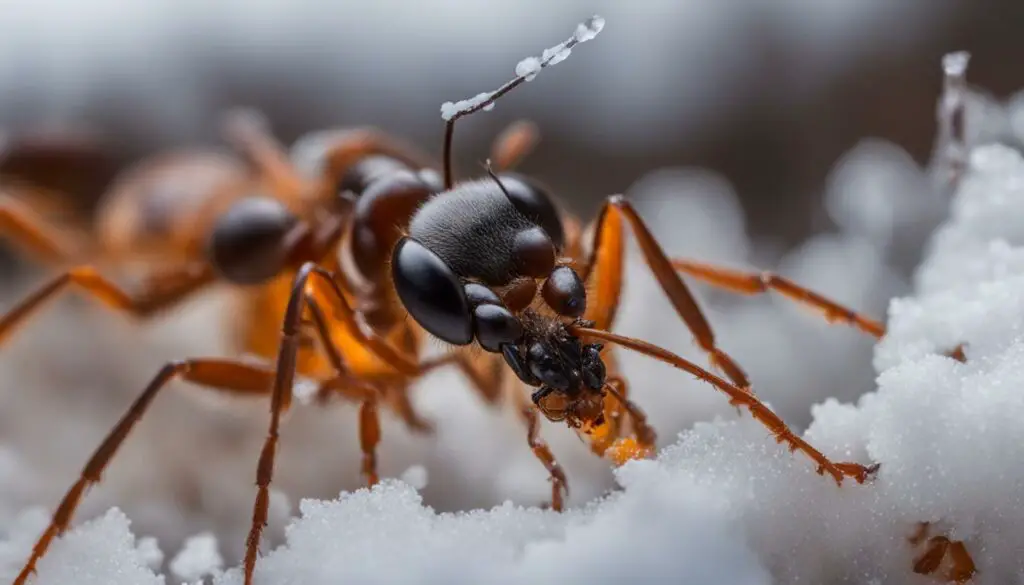
Tips for Enjoying Winter Ant Keeping
Winter ant keeping can be a fascinating and rewarding hobby. As you care for your ants during the dormant season, there are several tips that can enhance your experience and make the most of this unique time. From observing their resilience to finding joy in their behavior, here are some tips for enjoying winter ant keeping.
1. Embrace the Slower Pace
During winter, ants enter a state of hibernation where their activity slows down significantly. Instead of viewing this as a negative, embrace the slower pace and take the opportunity to observe their behavior in a more relaxed manner. Watch as they carefully tend to their nests, conserve energy, and navigate their surroundings with precision. The winter months offer a unique insight into the fascinating world of ants.
2. Provide Enrichment Activities
Although ants are less active during winter, they still benefit from mental stimulation and enrichment. Offer them intriguing challenges such as providing small obstacles or tunnels for them to explore. You can also introduce natural materials like twigs or leaves to their habitat for them to manipulate and interact with. These enrichment activities can help keep your ants engaged, even during their dormant period.
3. Document Their Winter Behavior
Winter ant keeping provides an excellent opportunity for documentation and research. Take notes or maintain a journal to record any changes in behavior, feeding patterns, or other observations. You can also capture photographs or create a time-lapse video to document their winter activities. Sharing your findings with other ant enthusiasts or scientific communities can contribute to the collective knowledge of ant behavior during the winter months.
Remember, winter ant keeping is a unique and special time to connect with these incredible creatures. By embracing their slower pace, providing enrichment, and documenting their behavior, you can make the most of your winter ant keeping journey.
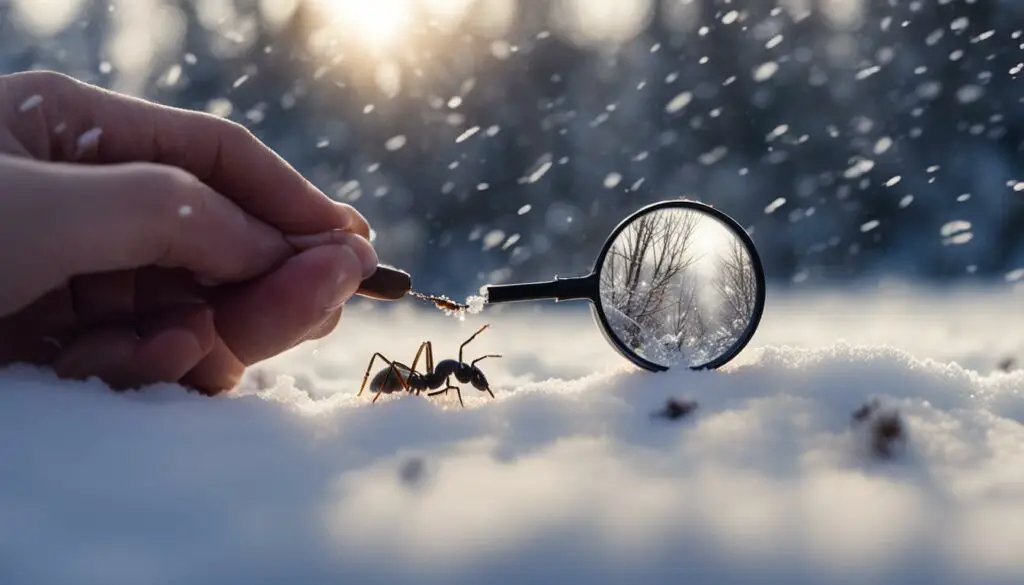
| Benefits of Winter Ant Keeping | Challenges of Winter Ant Keeping |
|---|---|
| Opportunity to observe unique winter behaviors | Slower activity and reduced nesting needs |
| Less risk of pests and infestations | Temperature and humidity management |
| Opportunity for research and documentation | Special dietary requirements |
| Increase in mental stimulation and enrichment | Monitoring and managing nest health |
Conclusion
In conclusion, mastering the art of keeping ants in winter requires careful attention and tailored strategies. By following the tips and techniques discussed in this comprehensive guide, you can provide your ant colonies with a safe and comfortable environment throughout the dormant season.
Remember, ants face unique challenges during winter, and it’s important to understand their natural behaviors and needs during this time. Creating suitable habitats, managing temperature and humidity, and providing proper nutrition and hydration are key factors in ensuring their health and survival.
Regular monitoring of ant health, identifying and preventing winter ant pests, and effectively managing ant nests and colonies are also crucial for successful winter ant care. By addressing common issues and troubleshooting challenges, you can overcome obstacles and provide optimal care for your ants.
Finally, enjoy the journey of winter ant keeping! From observing their unique behaviors to finding joy in their resilience, this experience can be truly rewarding. By implementing the tips and advice shared in this guide, you can make the most of your winter ant keeping journey and create a fulfilling relationship with these fascinating creatures.
FAQ
What are the challenges ants face during winter?
During winter, ants enter a state of hibernation and require different care compared to other seasons.
How can I create a suitable winter habitat for ants?
To create a suitable winter habitat, provide insulation, moisture control, and enough food storage for the ants.
How do I manage temperature and humidity for ants in winter?
You can manage temperature and humidity by using heating devices, thermal insulation, and misting systems.
What should I feed ants during winter?
Ants have different dietary needs during winter. I will provide detailed instructions on proper winter ant feeding.
How do I provide water for ants in winter?
Although ants require less water during winter, it’s still important to provide water sources for hydration.
How do I protect and maintain ant nests during winter?
I will provide detailed instructions on how to protect and maintain ant nests, including pest control methods.
What are common winter ant pests and how can I prevent infestations?
I will discuss common winter ant pests and provide effective prevention methods to keep your ants safe.
How do I monitor ant health during winter?
Regular monitoring of ant health is crucial during winter. I will guide you through the process of observing and assessing ant health.
How should I manage ant reproduction and queen care in winter?
I will provide recommendations for managing ant queens and ensuring successful overwintering of eggs.
What supplies and equipment do I need for winter ant keeping?
I will discuss the necessary items you should have, including heating devices, insulation materials, and food storage containers.
What should I do if I encounter challenges while caring for ants in winter?
I will address common problems and provide troubleshooting tips to help you overcome these issues.
Are there species-specific guidelines for winter ant care?
I will provide species-specific guidelines, addressing the needs and behaviors of popular ant species during winter.
What are the most frequently asked questions about winter ant care?
In this section, I will answer common concerns and queries related to keeping ants during winter.
How can I make the most of my winter ant keeping experience?
I will share tips and advice to help you enjoy your winter ant keeping journey and appreciate the unique behaviors of ants in winter.

